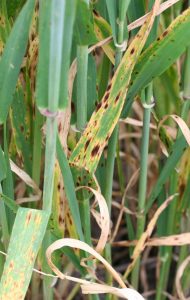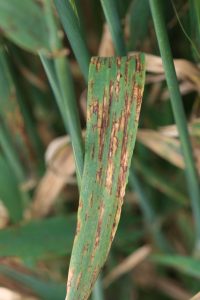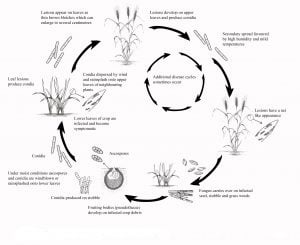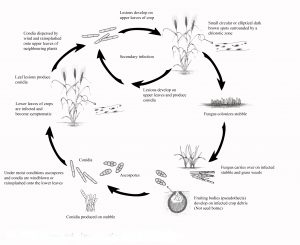There are two forms of net blotch that cause loss in Australia: the spot form (SFNB) and the net form (NFNB) of net blotch. The spot form is more common in Victoria, due to the widespread cultivation of susceptible varieties. The net form is becoming more prevalent due to the increased adoption of susceptible varieties. Both diseases can be effectively managed by using a combination of varietal selection, crop rotation, and fungicides.
What to Look For
Spot Form of Net Blotch
Symptoms are most commonly found on leaves but can occasionally be found on leaf sheaths. They develop as small circular or elliptical dark brown spots surrounded by a chlorotic zone of varying width. These spots do not elongate to form net like pattern characteristic of the net form. The spots may grow in diameter to 3-6 mm.
Net Form of Net Blotch
The net form of net blotch starts as pinpoint brown lesions which elongate and produce fine, dark brown streaks along and across the leaf blades, creating a distinctive net-like pattern. Older lesions continue to elongate along leaf veins and often are surrounded by a yellow margin.
Disease Cycle
Primary inoculum of both forms of net blotch comes from infected stubble. Net blotch can survive on infected barley stubble as long as the stubble is present on the soil surface, which is generally 2 years after the crop is harvested. However, it can be three years in drier environments.
Ascospores are produced by pseudothecia on the stubble residues, that are spread by rain-splash or wind to infect neighbouring plants. Most of these ascospores only travel short distances within the crop. Infection requires moist conditions with temperatures of 12-25°C, and is most rapid 15-20°C.
The disease cycles for the two forms of net blotch differ in that NFNB can be carried over on seed, while the SFNB is not seedborne. Carryover of NFNB onto seed occurs when humid conditions are present at crop maturity.
Secondary infection can occur repeatedly throughout the sea- son through conidia produced from lesions on leaves, usually within 14-20 days after primary infection. These lesions usually start on the lower leaves which then infect the upper leaves during moist conditions. Unlike the ascospores, conidia are wind dispersed and can travel considerable distances. The likelihood of infection decreases with distance from the source. As the barley plant begins to senesce, the fungus grows into the stem as a saprophyte. After harvest, it survives on the stubble and will begin producing ascospores when cool moist conditions are present.
Economic Importance
The prevalence of each net blotch is dependent on the variety susceptibility. Both net blotches can cause a significant grain yield and quality losses which can lead to downgrading of grain.
Yield losses from NFNB are generally 10 and 20 per cent, but losses of more than 30 per cent have been reported in severe cases. SFNB, generally causes losses of 5-15 per cent but in severe outbreaks can exceed 20 per cent. In general, the flag to flag-2 leaves must be infected for yield loss to occur.
Net Blotch Management
Both SFNB and NFNB can be effectively controlled with an in- tegrated strategy incorporating varietal selection, crop rotation, seed treatment and crop monitoring with a view to fungicide applications if required.
Varietal Selection
Avoiding growing susceptible (S) and very susceptible (VS) varieties and growing a variety with a rating of moderately susceptible (MS) or better significantly reduces the likelihood of grain yield and quality loss. Consult a current Victorian Cereal Disease Guide or the NVT website when selecting varieties.
Crop Rotation
Avoid growing barley in the same paddock in successive years as most inoculum survives in stubble. At least two seasons of break crops are required to reduce stubble and inoculum loads sufficiently to reduce risk. Disease levels will be higher in districts where barley crops are grown in close rotation.
Time of Sowing
Early sowing favours the development of the net blotches and can increases the potential for loss. Have a proactive approach to disease management in early sown crops, by applying up- front fungicides if possible and monitor with a view to application of foliar fungicides if needed during the season. Sowing later to avoid net blotch should be weighed up against other agronomic factors.
Seed Treatment
Seed treatments are registered for the net blotches. Seed treatments containing the active ingredient thiram can reduce NFNB severity in seedlings, while treatments containing the active ingredients difenoconazole + metalaxyl can reduce the carry-over of seed-borne NFNB. Fluxapyroxad is available for control of both net blotches in barley and is effective during the emergence and tillering stages of crop development and can provide control into the stem elongation stages. Ensure that other fungicides are used in rotation with fluxapyroxad as it has a SDHI mode of action which has a high risk of resistance developing in the pathogen.
Seed treatments are most effective when combined with an application of foliar fungicide with a different mode of action during the flag emergence growth stages of crop development
Foliar Fungicides
Foliar fungicide products are registered for suppression of net blotches. Monitor barley crops and apply a foliar fungicide when the percentage of leaf area affected by net blotches is greater than 10 per cent. Yield improvements from fungicide application are most likely where the disease is severe, and grain yield potential yield exceeds three t/ha.
For best suppression, foliar fungicides should be applied during early stem elongation (GS 31) and flag leaf emergence (GS 39). Application at late tillering (Z25) has also been shown to be effective in the shorter season Mallee environment. A single application of foliar fungicide may be insufficient to eliminate grain yield and quality loss where seasonal conditions favour net blotch development and a two application strategy may be warranted.
Application of foliar fungicide can be effective during the head emergence (GS49-59) growth stages but will provide less benefit for SFNB than NFNB.
Check the product label to ensure the fungicide is effective on the form of net blotch you have, and also, check withholding periods.
Foliar fungicides are less likely to improve grain yield in moderately susceptible or better rated varieties, except during exceptionally favourable, high yielding seasons and are therefore unlikely to be economical to apply.
Please note: This book is also available on AppleBooks







